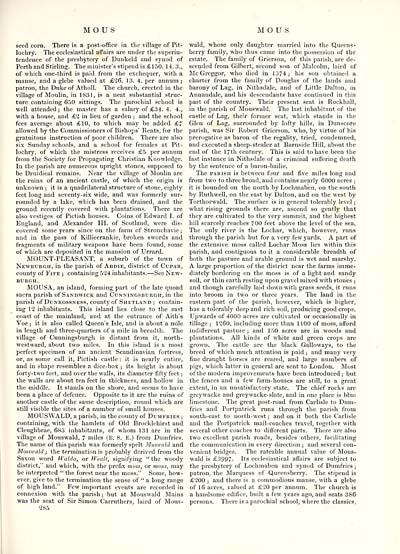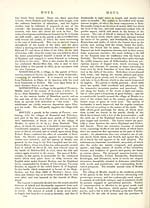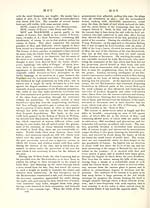Topographical dictionary of Scotland > Volume 2
(293) Page 285
Download files
Complete book:
Individual page:
Thumbnail gallery: Grid view | List view

M O U S
M O U S
seed corn. There is a post-office in the village of Pit-
lochry. The ecclesiastical affairs are under the superin-
tendence of the presbytery of Dunkeld and synod of
Perth and Stirling. The minister's stipend is £150. 14. 3.,
of which one-third is paid from the exchequer, with a
manse, and a glebe valued at £26. 13. 4. per annum ;
patron, the Duke of Atholl. The church, erected in the
village of Moulin, in 1831, is a neat substantial struc-
ture containing 650 sittings. The parochial school is
well attended ; the master has a salary of £34. 4. 4.,
with a house, and £2 in lieu of garden ; and the school
fees average about £10, to which may be added £7
allowed by the Commissioners of Bishops' Rents, for the
gratuitous instruction of poor children. There are also
six Sunday schools, and a school for females at Pit-
lochry, of which the mistress receives £5 per annum
from the Society for Propagating Christian Knowledge.
In the parish are numerous upright stones, supposed to
be Druidical remains. Near the village of Moulin are
the ruins of an ancient castle, of which the origin is
unknown ; it is a quadrilateral structure of stone, eighty
feet long and seventy-six wide, and was formerly sur-
rounded by a lake, which has been drained, and the
ground recently covered with plantations. There are
also vestiges of Pictish houses. Coins of Edward I. of
England, and Alexander III. of Scotland, were dis-
covered some years since on the farm of Stronchavie ;
and in the pass of Killiecrankie, broken swords and
fragments of military weapons have been found, some
of which are deposited in the mansion of Urrard.
MOUNT-PLEASANT, a suburb of the town of
Newburgh, in the parish of Abdie, district of Cupar,
county of Fife ; containing 524 inhabitants. — See New-
burgh.
MOUSA, an island, forming part of the late quoad
sacra parish of Sandwick and Cunningsburgh, in the
parish of Dunrossness, county of Shetland ; contain-
ing 12 inhabitants. This island lies close to the east
coast of the mainland, and at the entrance of Aith's
Voe ; it is also called Queen's Isle, and is about a mile
in length and three-quarters of a mile in breadth. The
village of Cunningsburgh is distant from it, north-
westward, about two miles. In this island is a most
perfect specimen of an ancient Scandinavian fortress,
or, as some call it, Pictish castle : it is nearly entire,
and in shape resembles a dice-box ; its height is about
forty-two feet, and over the walls, its diameter fifty feet ;
the walls are about ten feet in thickness, and hollow in
the middle. It stands on the shore, and seems to have
been a place of defence. Opposite to it are the ruins of
another castle of the same description, round which are
still visible the sites of a number of small houses.
MOUSWALD, a parish, in the county of Dumfries ;
containing, with the hamlets of Old Brocklehirst and
Cleughbrae, 683 inhabitants, of whom 131 are in the
village of Mouswald, 7 miles (E. S. E.) from Dumfries.
The name of this parish was formerly spelt Muswald and
Mosswald ; the termination is probably derived from the
Saxon word VVakla, or Wealt, signifying " the woody
district," and which, with the prefix moss, or mous, may
be interpreted " the forest near the moss." Some, how-
ever, give to the termination the sense of " a long range
of high land." Few important events are recorded in
connexion with the parish ; but at Mouswald Mains
was the seat of Sir Simon Carruthers, laird of Mous-
285
wald, whose only daughter married into the Queens-
berry family, who thus came into the possession of the
estate. The family of Grierson, of this parish, are de-
scended from Gilbert, second son of Malcolm, laird of
Mc Greggor, who died in 1374; his son obtained a
charter from the family of Douglas of the lands and
barony of Lag, in Nithsdale, and of Little Dalton, in
Annandale, and his descendants have continued in this
part of the country. Their present seat is Rockhall,
in the parish of Mouswald. The last inhabitant of the
castle of Lag, their former seat, which stands in the
Glen of Lag, surrounded by lofty hills, in Dunscore
parish, was Sir Robert Grierson, who, by virtue of his
prerogative as baron of the regality, tried, condemned,
and executed a sheep-stealer at Barnside Hill, about the
end of the 17th century. This is said to have been the
last instance in Nithsdale of a criminal suffering death
by the sentence of a baron-bailie.
The parish is between four and five miles long and
from two to three broad, and contains nearly 6000 acres ;
it is bounded on the north by Lochmaben, on the south
by Ruthwell, on the east by Dalton, and on the west by
Torthorwald. The surface is in general tolerably level ;
what rising grounds there are, ascend so gently that
they are cultivated to the very summit, and the highest
hill scarcely reaches 700 feet above the level of the sea.
The only river is the Lochar, which, however, runs
through the parish but for a very few yards. A part of
the extensive moss called Lochar Moss lies within this
parish, and contiguous to it a considerable breadth of
both the pasture and arable ground is wet and marshy.
A large proportion of the district near the farms imme-
diately bordering on the moss is of a light and sandy
soil, or thin earth resting upon gravel mixed with stones ;
and though carefully laid down with grass seeds, it runs
into broom in two or three years. The land in the
eastern part of the parish, however, which is higher,
has a tolerably deep and rich soil, producing good crops.
Upwards of 4000 acres are cultivated or occasionally in
tillage ; 1260, including more than 1100 of moss, afford
indifferent pasture; and 150 acres are in woods and
plantations. All kinds of white and green crops are
grown. The cattle are the black Galloways, to the
breed of which much attention is paid ; and many very
fine draught horses are reared, and large numbers of
pigs, which latter in general are sent to London. Most
of the modern improvements have been introduced; but
the fences and a few farm-houses are still, to a great
extent, in an unsatisfactory state. The chief rocks are
greywacke and greywacke-slate, and in one place is blue
limestone. The great post-road from Carlisle to Dum-
fries and Portpatrick runs through the parish from
south-east to north-west; and on it both the Carlisle
and the Portpatrick mail-coaches travel, together with
several other coaches to different parts. There are also
two excellent parish roads, besides others, facilitating
the communication in every direction ; and several con-
venient bridges. The rateable annual value of Mous-
wald is £3997- Its ecclesiastical affairs are subject to
the presbytery of Lochmaben and synod of Dumfries ;
patron, the Marquess of Queensberry. The stipend is
£200 ; and there is a commodious manse, with a glebe
of 16 acres, valued at £20 per annum. The church is
a handsome edifice, built a few years ago, and seats 386
persons. There is a parochial school, where the classics,
M O U S
seed corn. There is a post-office in the village of Pit-
lochry. The ecclesiastical affairs are under the superin-
tendence of the presbytery of Dunkeld and synod of
Perth and Stirling. The minister's stipend is £150. 14. 3.,
of which one-third is paid from the exchequer, with a
manse, and a glebe valued at £26. 13. 4. per annum ;
patron, the Duke of Atholl. The church, erected in the
village of Moulin, in 1831, is a neat substantial struc-
ture containing 650 sittings. The parochial school is
well attended ; the master has a salary of £34. 4. 4.,
with a house, and £2 in lieu of garden ; and the school
fees average about £10, to which may be added £7
allowed by the Commissioners of Bishops' Rents, for the
gratuitous instruction of poor children. There are also
six Sunday schools, and a school for females at Pit-
lochry, of which the mistress receives £5 per annum
from the Society for Propagating Christian Knowledge.
In the parish are numerous upright stones, supposed to
be Druidical remains. Near the village of Moulin are
the ruins of an ancient castle, of which the origin is
unknown ; it is a quadrilateral structure of stone, eighty
feet long and seventy-six wide, and was formerly sur-
rounded by a lake, which has been drained, and the
ground recently covered with plantations. There are
also vestiges of Pictish houses. Coins of Edward I. of
England, and Alexander III. of Scotland, were dis-
covered some years since on the farm of Stronchavie ;
and in the pass of Killiecrankie, broken swords and
fragments of military weapons have been found, some
of which are deposited in the mansion of Urrard.
MOUNT-PLEASANT, a suburb of the town of
Newburgh, in the parish of Abdie, district of Cupar,
county of Fife ; containing 524 inhabitants. — See New-
burgh.
MOUSA, an island, forming part of the late quoad
sacra parish of Sandwick and Cunningsburgh, in the
parish of Dunrossness, county of Shetland ; contain-
ing 12 inhabitants. This island lies close to the east
coast of the mainland, and at the entrance of Aith's
Voe ; it is also called Queen's Isle, and is about a mile
in length and three-quarters of a mile in breadth. The
village of Cunningsburgh is distant from it, north-
westward, about two miles. In this island is a most
perfect specimen of an ancient Scandinavian fortress,
or, as some call it, Pictish castle : it is nearly entire,
and in shape resembles a dice-box ; its height is about
forty-two feet, and over the walls, its diameter fifty feet ;
the walls are about ten feet in thickness, and hollow in
the middle. It stands on the shore, and seems to have
been a place of defence. Opposite to it are the ruins of
another castle of the same description, round which are
still visible the sites of a number of small houses.
MOUSWALD, a parish, in the county of Dumfries ;
containing, with the hamlets of Old Brocklehirst and
Cleughbrae, 683 inhabitants, of whom 131 are in the
village of Mouswald, 7 miles (E. S. E.) from Dumfries.
The name of this parish was formerly spelt Muswald and
Mosswald ; the termination is probably derived from the
Saxon word VVakla, or Wealt, signifying " the woody
district," and which, with the prefix moss, or mous, may
be interpreted " the forest near the moss." Some, how-
ever, give to the termination the sense of " a long range
of high land." Few important events are recorded in
connexion with the parish ; but at Mouswald Mains
was the seat of Sir Simon Carruthers, laird of Mous-
285
wald, whose only daughter married into the Queens-
berry family, who thus came into the possession of the
estate. The family of Grierson, of this parish, are de-
scended from Gilbert, second son of Malcolm, laird of
Mc Greggor, who died in 1374; his son obtained a
charter from the family of Douglas of the lands and
barony of Lag, in Nithsdale, and of Little Dalton, in
Annandale, and his descendants have continued in this
part of the country. Their present seat is Rockhall,
in the parish of Mouswald. The last inhabitant of the
castle of Lag, their former seat, which stands in the
Glen of Lag, surrounded by lofty hills, in Dunscore
parish, was Sir Robert Grierson, who, by virtue of his
prerogative as baron of the regality, tried, condemned,
and executed a sheep-stealer at Barnside Hill, about the
end of the 17th century. This is said to have been the
last instance in Nithsdale of a criminal suffering death
by the sentence of a baron-bailie.
The parish is between four and five miles long and
from two to three broad, and contains nearly 6000 acres ;
it is bounded on the north by Lochmaben, on the south
by Ruthwell, on the east by Dalton, and on the west by
Torthorwald. The surface is in general tolerably level ;
what rising grounds there are, ascend so gently that
they are cultivated to the very summit, and the highest
hill scarcely reaches 700 feet above the level of the sea.
The only river is the Lochar, which, however, runs
through the parish but for a very few yards. A part of
the extensive moss called Lochar Moss lies within this
parish, and contiguous to it a considerable breadth of
both the pasture and arable ground is wet and marshy.
A large proportion of the district near the farms imme-
diately bordering on the moss is of a light and sandy
soil, or thin earth resting upon gravel mixed with stones ;
and though carefully laid down with grass seeds, it runs
into broom in two or three years. The land in the
eastern part of the parish, however, which is higher,
has a tolerably deep and rich soil, producing good crops.
Upwards of 4000 acres are cultivated or occasionally in
tillage ; 1260, including more than 1100 of moss, afford
indifferent pasture; and 150 acres are in woods and
plantations. All kinds of white and green crops are
grown. The cattle are the black Galloways, to the
breed of which much attention is paid ; and many very
fine draught horses are reared, and large numbers of
pigs, which latter in general are sent to London. Most
of the modern improvements have been introduced; but
the fences and a few farm-houses are still, to a great
extent, in an unsatisfactory state. The chief rocks are
greywacke and greywacke-slate, and in one place is blue
limestone. The great post-road from Carlisle to Dum-
fries and Portpatrick runs through the parish from
south-east to north-west; and on it both the Carlisle
and the Portpatrick mail-coaches travel, together with
several other coaches to different parts. There are also
two excellent parish roads, besides others, facilitating
the communication in every direction ; and several con-
venient bridges. The rateable annual value of Mous-
wald is £3997- Its ecclesiastical affairs are subject to
the presbytery of Lochmaben and synod of Dumfries ;
patron, the Marquess of Queensberry. The stipend is
£200 ; and there is a commodious manse, with a glebe
of 16 acres, valued at £20 per annum. The church is
a handsome edifice, built a few years ago, and seats 386
persons. There is a parochial school, where the classics,
Set display mode to: Large image | Transcription
Images and transcriptions on this page, including medium image downloads, may be used under the Creative Commons Attribution 4.0 International Licence unless otherwise stated. ![]()
| Gazetteers of Scotland, 1803-1901 > Topographical dictionary of Scotland > Volume 2 > (293) Page 285 |
|---|
| Permanent URL | https://digital.nls.uk/97364646 |
|---|
| Description | Volume II: From Keanlochbervie to Zetland. |
|---|---|
| Attribution and copyright: |
|

